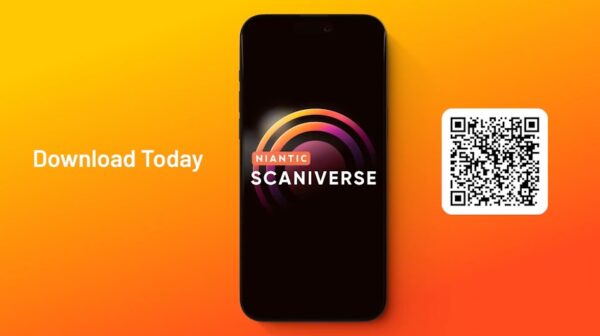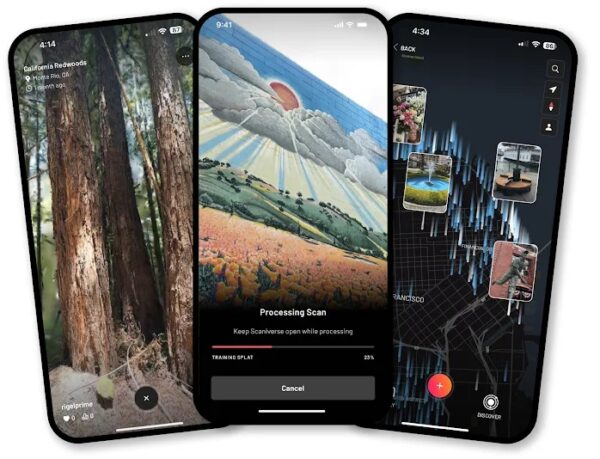In Augmented Reality and Virtual Reality News
August 27, 2024 – Niantic, a provider of augmented reality (AR) technologies and the creator of the AR mobile game Pokemon GO, has this week announced that it has launched a major update to its Scaniverse platform, with ‘Scaniverse 4.’ The update allows users to upload 3D scans of real-world scenes and objects to a new shared spatial map of the world, and also adds the ability to use these ‘Gaussian splats’ in Niantic Studio.
What is a Gaussian Splat?
3D Gaussian Splatting is a technique in computer graphics that allows for real-time rendering of photorealistic scenes. It works by converting a 3D point cloud—which is a collection of data points that map the surface of an object or scene in three-dimensional space—into smooth, blurry points called ‘Gaussians.’ These Gaussians are then refined and rendered to produce highly detailed and natural-looking images quickly.
What is Scaniverse?
In 2021, Niantic acquired Scaniverse, a 3D scanning mobile application that pioneered a fast and user-friendly way to capture, edit and share 3D content using a smartphone camera. Millions of people have used the app to capture objects and places in 3D using their smartphones.
A few months ago, Scaniverse added on-device Gaussian splatting to allow for the creation of 360-degree, fully immersive 3D models that are more accurate, more vibrant, and faster to render than previous technologies, according to Niantic. The company’s SVP of engineering and co-creator of Google Earth, Brian McClendon, called Gaussian splats “the biggest change to computer graphics since real-time texture mapping in 1991.”

What does this announcement from Niantic mean?
With this latest announcement from Niantic, it means that Scaniverse takes splats beyond a user’s phone and onto a map of the real world. Splats will now join millions of previous contributions from players of Niantic’s games Wayfarer, Ingress, and Pokémon GO, which were originally used by the company to help it create and verify places to go in the games.
Niantic is now reprocessing many of these contributions into splats, meaning the company’s map of the world already has a significant number of scans to explore already.
How do users make splats with Scaniverse?
Niantic stated that making splats with Scaniverse is simple and requires no 3D rendering experience. Users can capture, generate, and share a fully immersive view of any public place, using nothing but a smartphone. After uploading to the map, users can then share a cinematic video of their scene on social media, or share the link with others.
To create a scan, a user simply needs to move their camera around to capture all angles of an object or scene. It then takes about one minute for the Gaussian splat to reconstruct, after which it is ready to be uploaded to the Scaniverse map. Niantic added that everything stays on a user’s phone until they choose to share it, and nothing goes on the map without a user’s permission.
Processing splats directly on device was a breakthrough that Niantic added to Scaniverse earlier this year. Now iOS users can add those splats directly to the company’s new map. However, while iPhone users will be able to post and browse scans to the map today, Niantic noted that it will be adding this new map to the Android version of Scaniverse soon.

Does Niantic Studio support Gaussian splats?
Niantic also announced support for splats in Niantic Studio, a WebXR editor and web gaming engine from Niantic 8th Wall. Developers can now create or discover splats in Scaniverse and upload them to Niantic Studio to use as a canvas for web games and VR experiences.
Combined with Niantic’s powerful VPS (Visual Positioning System) with its centimeter-level precision, the company stated that developers now have the tools to make the real world the backdrop of their AR and VR experiences.
Niantic stated that bringing these new splats into a map that can be shared and explored is a big part of the company’s ongoing efforts to build a map for spatial computing that goes beyond its games. Commenting on this, the company stated: “Niantic got its start developing cloud-based games for the real world; now, we’re working towards modeling the world in 3D as a canvas for everyone else.”
For more information on Niantic and its AR technologies, please visit the company’s website.
Image / video credit: Niantic / YouTube
About the author
Sam is the Founder and Managing Editor of Auganix, where he has spent years immersed in the XR ecosystem, tracking its evolution from early prototypes to the technologies shaping the future of human experience. While primarily covering the latest AR and VR news, his interests extend to the wider world of human augmentation, from AI and robotics to haptics, wearables, and brain–computer interfaces.
